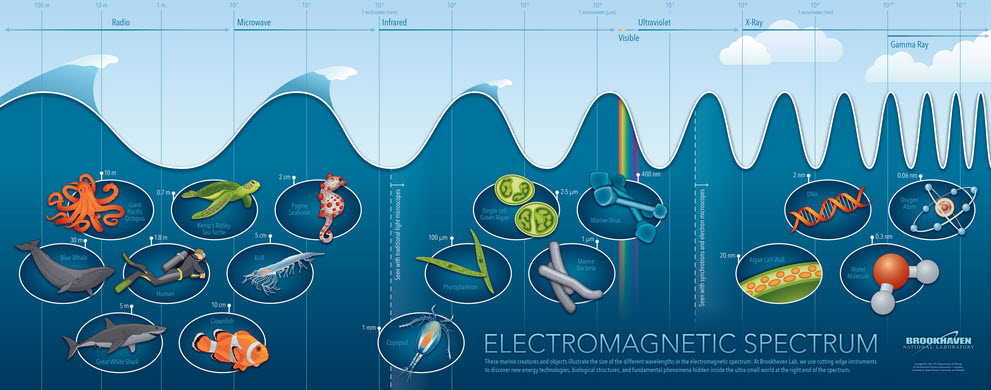[+]

These marine creatures and objects illustrate the size of the different wavelengths in the electromagnetic spectrum (credit: BNL designer Tiffany Bowman and writer Justin Eure) (click the image and then the magnifying glass to enlarge the diagram)
An infographic created by the Department of Energy’s Brookhaven Lab uses ocean creatures and objects to illustrate the extraordinary range of wavelengths (the inverse of frequencies) in the electromagnetic spectrum — from radio waves to gamma rays — and the lab’s role in research at these wavelengths. (The spectrum actually extends beyond the objects shown here.)
Many of these objects, including the 30-meter blue whale or the 2-centimeter pygmy seahorse, can be easily seen with the naked eye. But scientists and students must use microscopes and similar devices to see the objects in the middle of the spectrum, including algae and viruses. At the right end of the spectrum shown here, at the nanoscale, more sophisticated instruments are required.
To reveal structural details the size of DNA, the labs uses powerful x-rays produced at the National Synchrotron Light Source II, precise electron microscopes at the Center for Functional Nanomaterials, and a host of other sensitive instruments and techniques. Investigating materials at that scale — from lithium-ion batteries to cell-building proteins — allows fundamental discoveries that can revolutionize our understanding of biology, energy technology, and even the cosmos.
The world below that starts with atoms, measured in Angstroms (.1 nanometer) or picometres (trillionths of a meter), and below that, the fermi (millionth of a nanometer) — the world of subatomic phenomena explored by Brookhaven Lab scientists with the Relativistic Heavy Ion Collider.
No comments:
Post a Comment